If you have aphids on your indoor plants it’s important that you eliminate them and protect your plant from future infestations! Growing plants indoors can be an enjoyable and fruitful hobby year round, but even though you are inside you still need to be on the lookout for pests.
To get rid of aphids on indoor plants, remove the aphids manually or by using insecticidal soap. Remove aphids by hand, or with the use of a cotton swab, a brush, or spraying with water if the infestation is small. For larger infestations, eliminating aphids may require using an insecticide.
There are many different methods to removing aphids, and the delicacy of your plant will help you determine the right course of action.
Some plants need more gentle treatment, while others can handle being sprayed down to eliminate an aphid colony! In this article I will share with you a variety of ways to get rid of aphids on indoor plants, so you can make the right choice for yours!
How To Get Rid Of Aphids On Indoor Plants
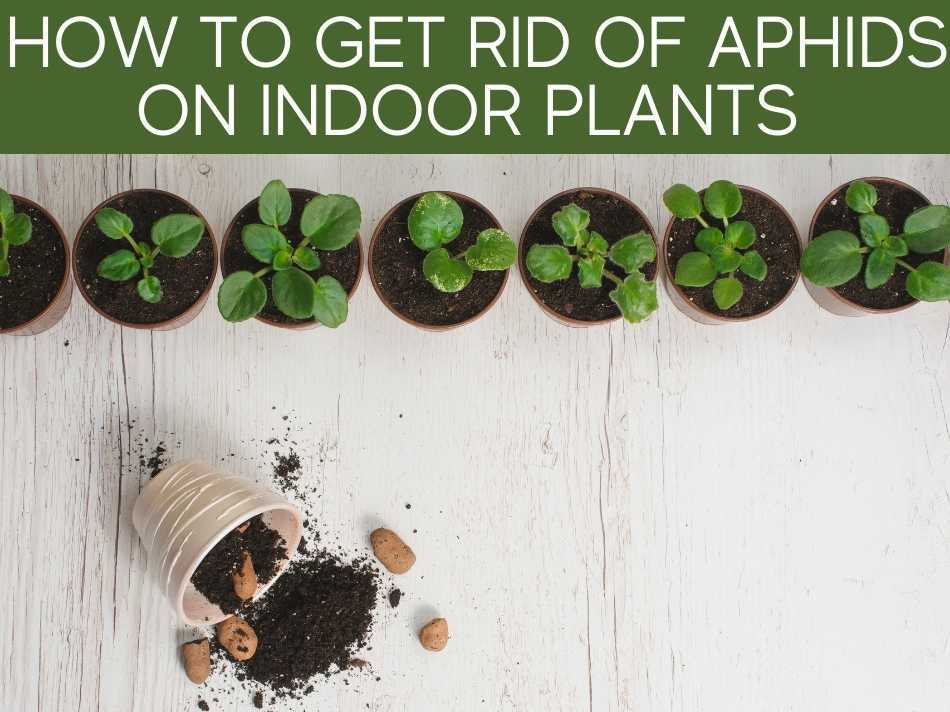
Aphids are such tiny little creatures, but boy can they be annoying in multitudes!
The best way, with all pests, is to try to avoid them in the first place.
Inspect your plants weekly, checking underneath leaves and especially around the base of the stem and try to get ahead of the aphids before they make themselves at home!
But if you are already in the trenches with an aphid colony all over your beloved indoor plants, I am here to help you get rid of them.
Aphids must be removed from the plant either manually or with the use of an insecticide, and treatment should be repeated until all aphids are removed.
The first method of removing aphids from your indoor plants is to do it manually.
You can remove aphids manually by:
- Hand picking
- Wiping them off with a cotton swab dipped in rubbing alcohol
- Brushing them off with a soft bristle brush
- Spraying them off with water
Removing aphids manually truly is more time consuming, but if the infestation is small enough it is going to be the most immediately effective method (as long as you make sure you get them all!).
Although this method is thorough and immediately effective, you will likely need to repeat the process 2-3x over the course of a week, or until you stop finding them!
Be sure to regularly check your plants for aphids going forward and remove any you find immediately!
Remember, the best treatment is prevention.
How To Get Rid Of Aphids On Indoor Plants Using Insecticide
Another option for getting rid of aphids on houseplants is to treat your plant with an insecticide or homemade remedy.
Common chemical treatments for aphids include:
- Store bought insecticidal soap
- Neem oil spray
- Indoor use insecticides
- Imidacloprid plant spikes
The use of insecticide soap or neem oil properly diluted according to it’s instructions, will effectively smother and kill the aphids.
This treatment must be applied regularly though, because it only kills the aphids on the plant at the time it is sprayed.
Store bought indoor plant insecticides can be used as well, but only if necessary, since they can kill pollinators if you regularly bring your plants outside.
How To Control Aphids On Houseplants
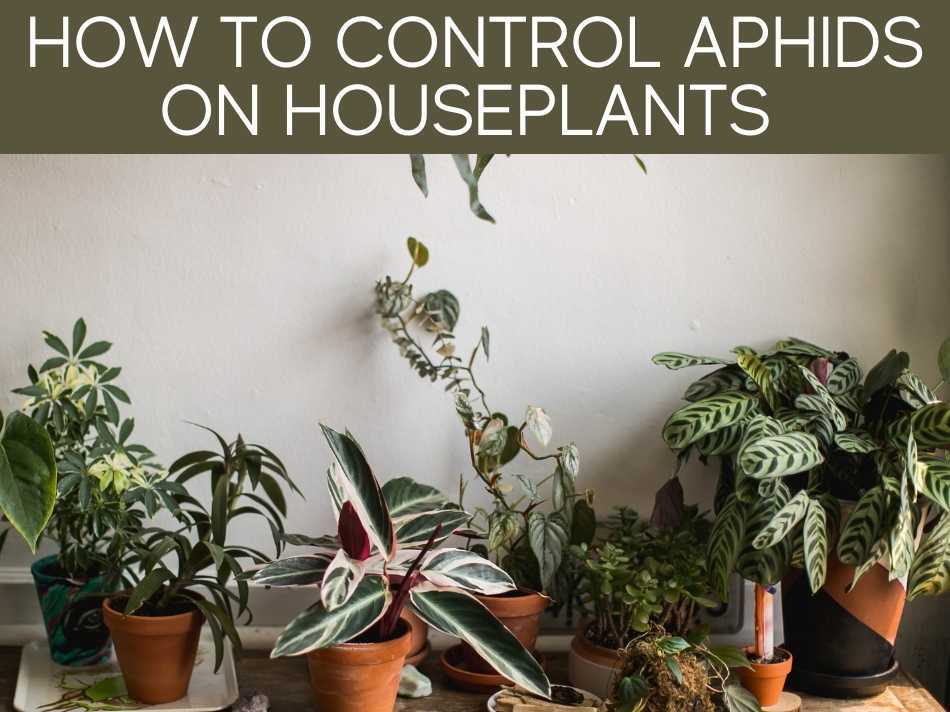
Aphids in small numbers are fairly easy to manage, but as their colony expands they can really cause some damage!
So it is best to try and stay ahead of the aphids, and not let an infestation grow.
Indoor plants are still susceptible to pests like aphids so it’s necessary to keep an eye out for them!
To control aphids on your houseplants you must regularly inspect your plants and remove aphids manually or by chemical means.
When looking to control the aphid population in your indoor plants the very first step is prevention.
When purchasing a new plant or bringing it in from outside you should inspect it thoroughly for any signs of pests.
Another prevention tip is to use clean potting soil and sterile pots for your indoor plants.
If you do find yourself with some aphids though, you need to remove them!
To remove aphids by hand you can:
- Pick them off with tweezers
- Brush them off with a soft brush
- Wipe them away with a cotton swab dipped in rubbing alcohol
- Spray them with water
Doing this once will not be enough.
You must continue checking your plant regularly and consistently to make sure the aphids don’t come back!
How to control aphids with chemical insecticides
You can also use chemicals to control aphids in your indoor plants.
When considering insecticides it is a good general rule to use the most gentle method first, and work your way up to the more intense treatments if needed!
The best insecticides for aphids, in suggested order of use is:
- Insecticidal soap spray
- Neem oil spray
- Pyrethrins insecticides
- Imidacloprid plant spikes
Saving the pyrethrins and imidacloprid methods for extreme cases is best, especially for plants that you occasionally bring outside, because these chemicals are toxic to bees and other pollinators!
How to get rid of aphids in potted plants
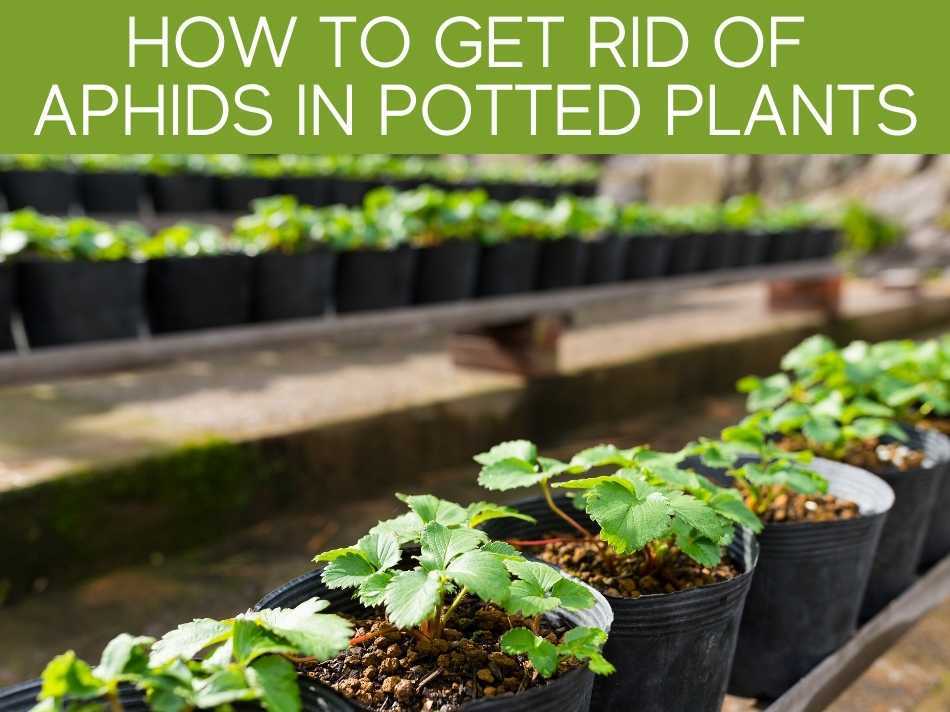
Finding aphids on your plants can be disappointing and, depending on the severity, alarming!
But not to worry, removing aphids can be quite easy (though often time consuming!).
To get rid of aphids in potted plants you can remove them physically with tweezers or a water spray, or use insecticides to kill or prevent them.
When inspecting your plants for aphids, be extremely thorough!
Look underneath leaves, around the base of the stems, use a magnifying glass if you need to.
Since many aphids are light green in colour they can be sometimes difficult to spot.
Check out the full guide on how to get rid of aphids in the garden.
You should be regularly inspecting your plants for pests and signs of disease before you ever have a problem, this will help you spot any pest problems early!
If you find a small amount of aphids the easiest way to get rid of them is to just simply pick them off.
If you feel nervous about damaging the leaves of your plant by picking them off by hand, some other methods you can use are:
- Brushing them off with a soft brush
- Using tweezers to pick them off
- Using a cotton swab dipped in alcohol to wipe them off
- Spray them off with water
If you have a large colony of aphids or you don’t have the time to pick them all off by hand, you can also use insecticides to remove them.
Insecticidal soap is a very effective method to remove aphids, but the treatment must be repeated since it only kills the aphids that it is directly sprayed on.
Harsher chemicals such as imidacloprid or pyrethrins have longer lasting results, but they are much more toxic chemicals!
If you bring your indoor plants outside regularly, try to avoid the use of these insecticides since they are toxic to pollinators!
How to get rid of aphids on indoor plants naturally
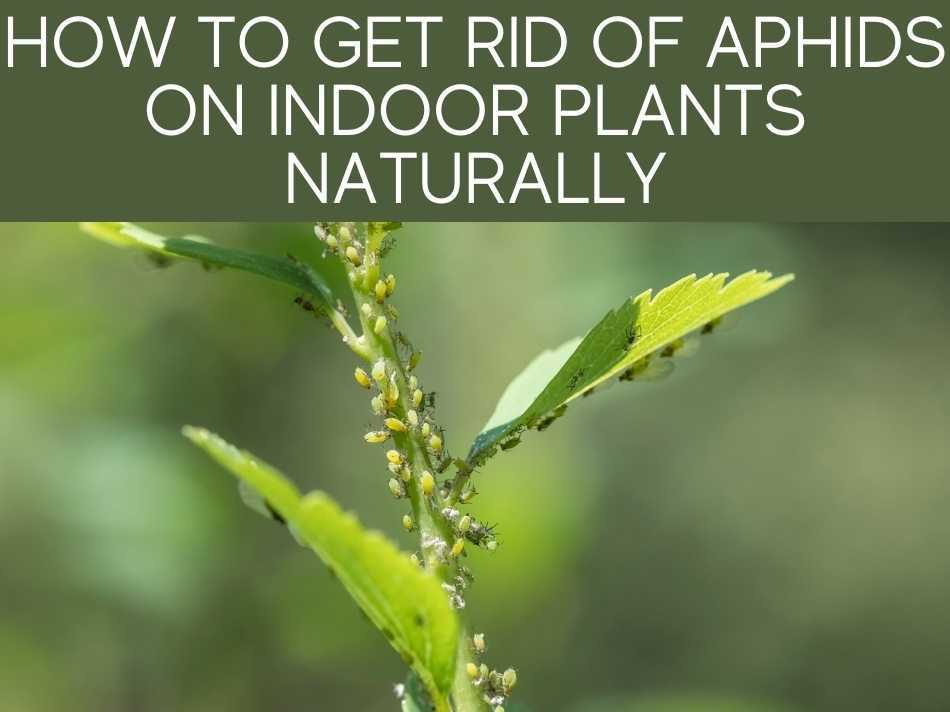
Aphids, although annoying, are generally easy to get rid of naturally.
To get rid of aphids naturally you can remove them by hand or use natural insecticides such as neem or canola oil.
The most natural way you can get rid of aphids is simply to pick them off your plant!
Check out our complete guide to getting rid of aphids naturally.
You can pick or brush aphids off by hand, or with a tool of your choice.
Using a soft paint brush or tweezers works well and is gentle on the foliage of your plant!
Taking your plant outside and spraying it with water will also work to dislodge the aphids.
If you don’t have the time to pick off all the aphids, or are wanting something that kills them, not just removes them, using a natural insecticide is also a good choice.
Neem oil or canola oil work well to smother the aphids and kill them.
To use neem oil on your indoor plants you can buy a premade spray or make a homemade emulsion.
However, to avoid possible damage to your plants it is recommended that you purchase a neem oil product specifically made for pest management!
Natural methods are very effective against aphids and only in extreme cases should you need to resort to harsher chemicals!
Remember though, prevention of aphids is truly the most effective way in dealing with them!
Inspect your plants thoroughly 1-2x per week, especially after treatment… you want to make sure you stay ahead of any future infestations!
How to get rid of aphids on indoor chilli plants
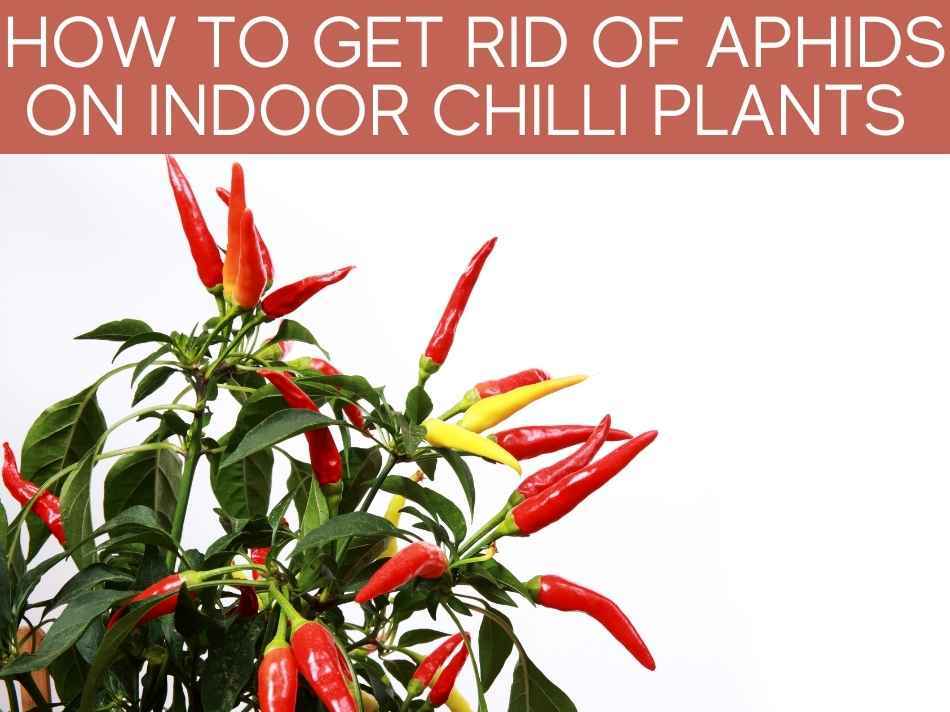
Indoor gardening can be so rewarding and fruitful all year round, so when aphids make their way into your precious chilli plants you want to stay on top of them!
Use insecticidal soap to get rid of aphids on indoor chilli plants, or remove the aphids by hand.
Since you plan to eat your chilli peppers it is best to avoid harsh chemicals when dealing with aphids, unless absolutely necessary.
The most natural way to get rid of aphids is to remove them manually.
To remove aphids manually you can use:
- Tweezers
- Your hand
- A soft brush
If the infestation is too big to tackle with manual removal, it’s time to look at your other options!
Store bought insecticidal soap is an extremely effective and time-saving way to get rid of these pesky little bugs!
It may be tempting to make your own insecticidal spray, but it is not recommended.
Homemade insecticidal sprays can burn your plant since the ingredients are not controlled and tested for pest management.
In order to effectively kill all of the aphids on your chilli plant, you must repeat this treatment as needed until all of the aphids are gone!
Using pyrethrins to get rid of aphids on your indoor chilli plant is also an impressively effective option!
How to get rid of aphids on indoor herb plants
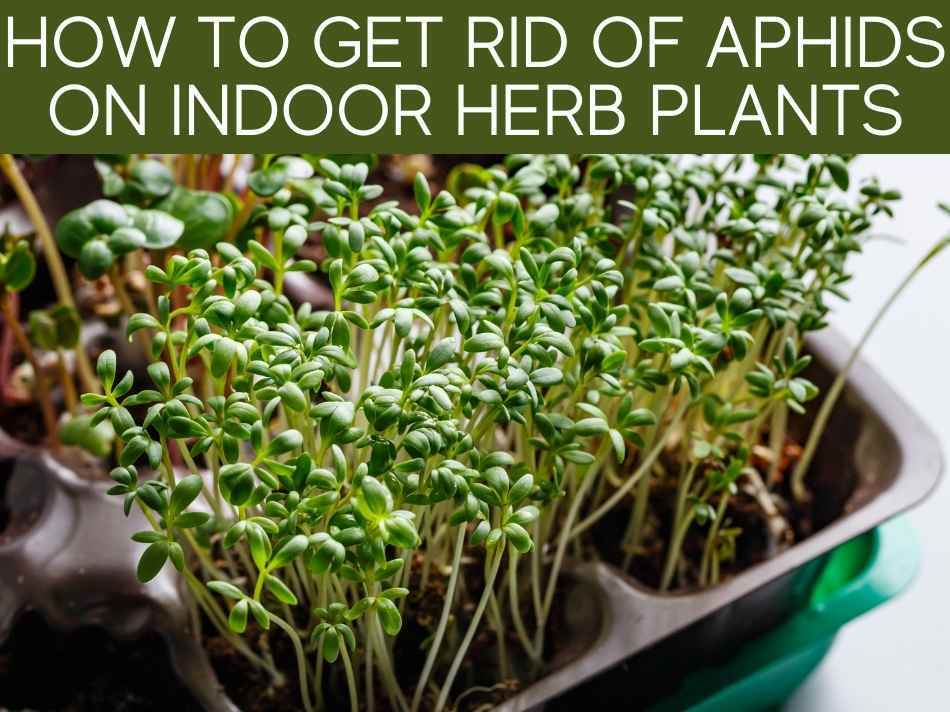
When dealing with indoor herb plants, you want to be as natural and gentle as possible when it comes to removing aphids.
Since you will be wanting to eat your delicious herbs, it’s best to avoid the use of heavy duty insecticides.
Aphids are pretty easy to manage using natural methods anyway, lucky you!
To get rid of aphids from indoor herb plants you can remove them by hand or use food-safe insecticides to kill them.
The first option you should try when dealing with aphids on your indoor herbs is to manually remove them.
- Pick or brush them off gently by hand
- Use tweezers to gently remove aphids from foliage and stems
- Use a soft paint brush or toothbrush to dislodge the aphids
- Dip a cotton swab in rubbing alcohol and wipe aphids off leaves
Although this method is time consuming (especially if you are dealing with a large colony) it is natural, gentle and food-safe!
If you don’t have the time for this, however, there are some food-safe chemical options you can use.
- Neem oil spray
- Insecticidal soap
- Pyrethrins insecticides
Insecticidal soap is a great option for getting rid of these annoying little bugs, and although you need to repeat the treatment many times to eliminate all the aphids, it is quick, easy and food-safe!
If you need to resort to something more intense, using a pyrethrin product (preferably a spray) is also a food-safe option!
If you are dealing with a large infestation of aphids in your household plants that you just can’t seem to keep under control, this might be your best option!
How to get rid of aphids on basil plants
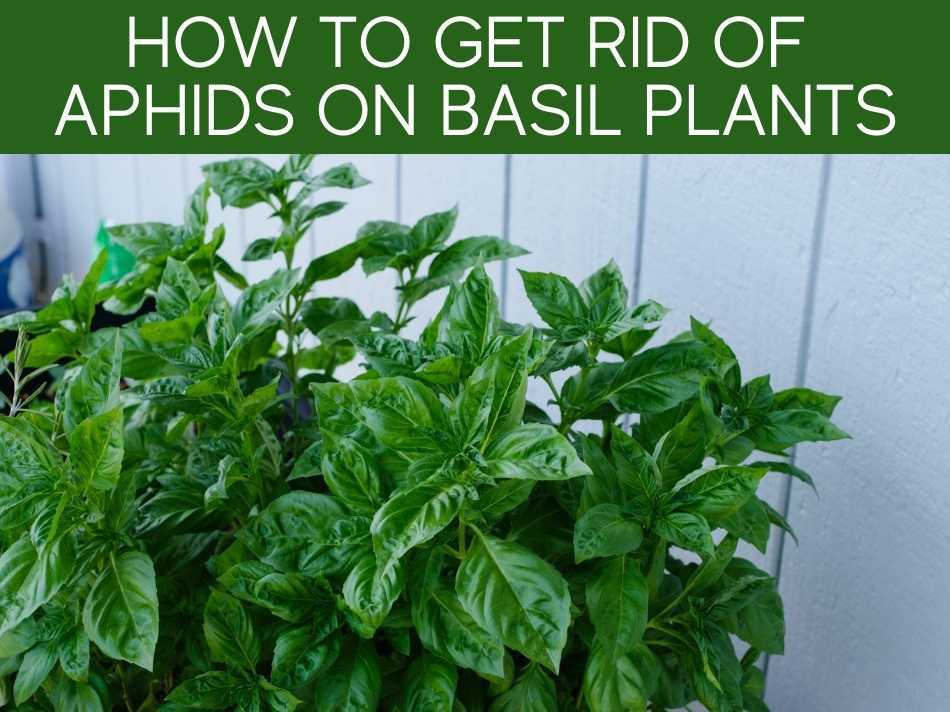
Oh basil, what a delicious little herb to grow year-round!
When you bring home a basil plant from the store you may assume that it is healthy and pest free, but don’t be so sure!
To get rid of aphids on basil plants you must physically remove them, or use a food-safe insecticide to kill them.
It is important to thoroughly inspect your plant before you purchase it, but to also keep a close eye on it at home.
The best way to avoid pests like aphids is to prevent them, so check under leaves and around the base of the stem.
If you find any aphids or other pests you should isolate your basil for 3-4 weeks while you are actively treating it!
To physically remove aphids you need to be gentle on your plant.
Use a light touch to brush or pick off any of the aphids; you may find using tweezers or a soft toothbrush to be easiest.
Once you have removed all of the aphids you must continue to thoroughly inspect your plant 1-2x per week to make sure they don’t come back!
Using insecticides that are approved for food crops is also a great choice for removing aphids from basil plants!
- Insecticidal soap
- Neem oil spray
- Pyrethrin insecticides
These are all safe options for your basil plant!
Insecticidal soap is gentle and effective against aphids, but treatment ust be repeated regularly until all of the aphids are gone.
If you have a large crop of indoor basil, or just a really resistant colony of aphids, you may consider using a stronger insecticide with pyrethrins.
Pyrethrin spray will work safely to kill the aphids, and will be effective for a few hours at a time!
You will still likely need to repeat the treatment, but it is a great long-lasting solution!
How to get rid of aphids on chives
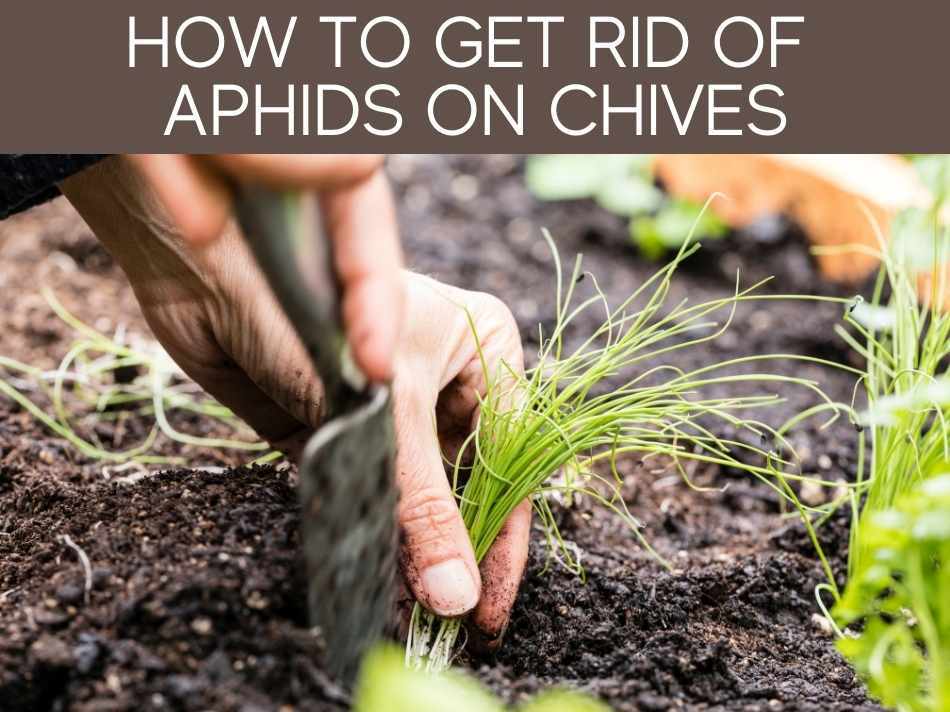
Growing chives indoors is easy and enjoyable, but unfortunately it is not guaranteed to be pest-free!
If you have found aphids on your chives it’s important to act immediately and remove them!
Aphids can multiply very quickly, so trying to catch the infestation early will make them easier to get rid of.
To get rid of aphids on indoor chives you need to use food-safe insecticide methods or remove the aphids by hand.
Manual removal options:
- Brush off (toothbrush, paintbrush, cotton swab, fingers)
- Pick off (tweezers, fingers)
- Spray off outside with a hose
These manual removal options are great for early and relatively small infestations, because it is the most gentle and obviously safe for food crops!
If you need extra help though, there are some pesticide options that are safe for your chives and work much faster against larger colonies than picking them all off by hand!
Some food crop approved insecticides against aphids are insecticidal soap, neem oil spray and pyrethrin sprays.
Insecticidal soap and neem oil both work to smother the aphids and kill them.
However, it is only effective on the aphid that it is sprayed on directly, so multiple applications will likely need to be made.
Reapply the treatment every 7-10 days to protect your plant from possible burns from the product.
Pyrethrin sprays are a great option if nothing else has worked for you to get rid of the aphids.
It is safe for food-crops, but still a less desirable choice especially if you have pets or small children around your indoor plants.
How to get rid of aphids on indoor hibiscus
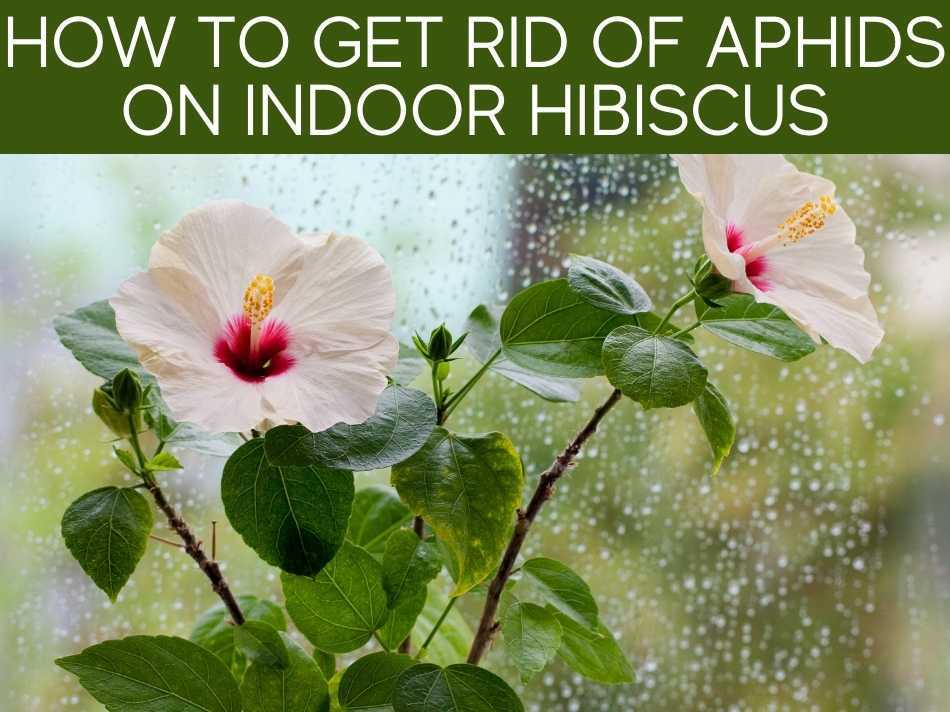
Hibiscus is such a beautiful and fragrant flower, and one that you likely take pride and joy in growing in your home.
If you find aphids on your precious hibiscus, you will want to act quickly before the aphids make lunch out of the flower and cause the foliage to wilt and curl!
To get rid of aphids on indoor hibiscus you can remove them manually or with the use of insecticides.
Depending on how many aphids have made your hibiscus their own personal buffet, you may be able to get rid of them simply by removing them.
You can remove them by hand, with a pair of tweezers or with a soft brush.
If, however, the infestation is too far gone for this manual treatment it may be time to turn to using some chemical insecticides.
How to get rid of aphids on indoor hibiscus using insecticides
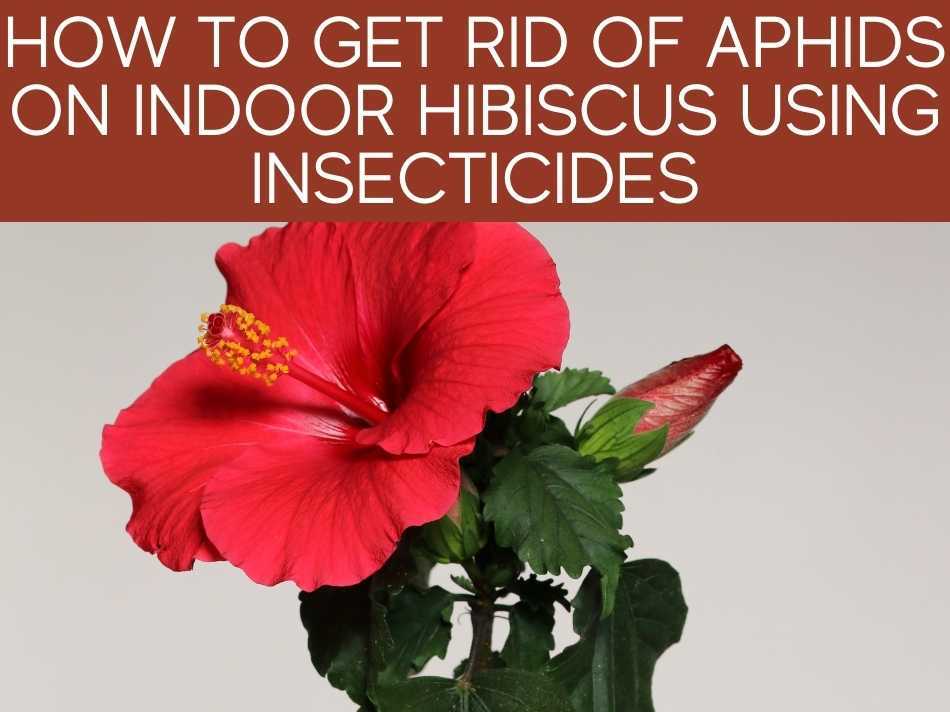
When using insecticides it is good practice to use the most gentle and non-toxic options first, and only use the more heavy duty options as a last resort.
This is especially true if you have pets or small children around your indoor plants.
The more gentle and virtually non-toxic insecticides you can use against your pesky aphid squatters are:
- Insecticidal soap
- Neem oil spray
These sprays work to suffocate the aphids and kill them when they come into direct contact with them.
You will need to reapply these every 7-10 days until all of the aphids are gone.
A slightly more intense option is the use of a pyrethrin spray, which works to paralyze aphids and continues working on the surface of the plant for a few hours after it is applied.
However, imidacloprid is a pretty intense chemical especially for use indoors around pets or small children and should only be used as a last resort after considering the safety precautions!
